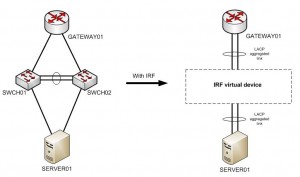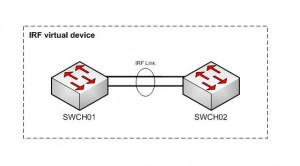HP A-Series switches, IRF and MAD overview
Intelligent Resilient Framework (IRF) is HP's switch platform virtualization technology, which allows us to create one logical switch from two or more physical switches. It was originally developed by H3C, which was a joint venture between Huawei and 3COM (later on entirely taken over by 3COM) and become part of HP after 3COM's acquisition in 2010. This technology generally is analogous with Cisco's VSS and vPC technologies, although it is independently developed and uses proprietary protocols (Cisco's VSS and vPC are also different, but that's topic for another discussion).
Some of the biggest advantages for combining multiple separate physical devices into one single logical one, are:
- Fast failure convergence time, which in the case of IRF is below 40miliseconds.
- Higher port density, which is due to the combination of ports
- Ability to span LACP aggregated links over multiple physical switches and benefit from the higher throughput and the higher availability.
- Drastic simplification of the network topology, which is achieved by the reduction of unused backup links.
- Simpler management of a single logical device, in contrast of managing multiple physical devices.
- Etc.
In order to illustrate better what has been said so far a diagram is provided below, which demonstrate the transformation of the network topology after IRF implementation:
To create an IRF virtual device we have to connect members together through an IRF link. This link is created between 2 logical IRF ports, which are associated with physical ports in the member switches, that are going to form the IRF virtual device.
After a logical switch is created via IRF, member switches create an IRF virtual device, which acts as a single layer 2 switch, layer 3 switch (for all protocols) and shares single management IP address. Each of the member switches perform one of the following roles:
- Master - responsible for management if the IRF virtual device. Master role is assumed only by one member of the IRF virtual device at a time, and there couldn't be more than one.
- Subordinate - backup of the master
In case of master failure, automatically a new master is being elected from the available subordinates. Master election process could be influenced by priority value, which could be set at the IRF virtual device member switches. The higher priority is more likely to become a master and the default priority on all switches is 1. In order to distinguish the members in an IRF virtual device member ID value is being used and additionally all members of the IRF virtual device are part of a single IRF domain, which is being distinguished by unique domain ID value, which by default is 0. A recommended approach is to change the default value to a different one, which is the same on all member switches, because otherwise the LACP MAD descision process cannot function properly.
After we mentioned MAD, it's good time to explain that part too. MAD, or Multi-Active Detection is a mechanism, which protects the master switch of an IRF virtual device from another switch with similar configuration that meets master criteria. The action, that MAD takes is to shut down one of the switches. In that case the switch, which remains online becomes active and continues to operate all the traffic. in order to detect the multiple active IRF switches that comply with the master criteria MAD uses one of the following methods:
Additional IRF and MAD information could be read here, including advanced configuration instructions.
The following platforms are supported for IRF implementation: A12500, A10500 A9500, A7500, A5820, A5800, and A5500 series switches. These products could be used for access, distribution and core layers of the network. For additional information: read more here.


March 25th, 2017 - 03:05
Although this is a very predictable mechanism, the used diagrams also show that the side with the lowest master unit ID will win, so in this example, only 1 switch will remain online, shutting down the other 3 devices. The same could happen with an IRF with 8 systems of course.